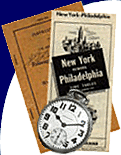Images of Rail - Yakima Valley Transportation Company, Kenneth G. Johnsen
Images of Rail - Philadelphia Railroads, Allen Meyers and Joel Spivak
Both published by Arcadia Publishing in the softbound "Images" series
I'm pretty sure we are all aware of and familiar with the Arcadia Publishing "Images of" format – find a niche with a lot of photographic documentation, with an expert historian to write a short history and structure the book based on a sensible historical framework. The book is then packaged into a fairly low cost, impulse-buy, soft cover edition, but with high quality resolution for old photos reduced to two postcard-sized images per page. I've seen and reviewed several of these books, and found each of them had merit, some more than others, variability based on the expert historian's ability to tell an interesting story, and the interest in the imagery that illustrates it. At best, they take you on a short ride back in time and give you a good grounding in an historic niche – at worst, at least you get a sense of what happened somewhere and have some good reproductions of historic photos to compare with what you can find today, or for modeling... in no case have any I've seen been worthless.
Yakima Valley Transportation Company is a fortunate choice. The historian knows his history, there are many images covering a lot of ground to choose from, and the company lasted from the early days of the trolley era right into the recent preservation era, making a lot of interesting changes along the way. A wide range of scenery, different rolling stock, streetscapes and rural interurban lines, and seeing then change over time as the structure of the book takes you through it via temporal rather than geographic chapters makes for a lot of interesting variation. There's a decent amount of technical stuff here as well as the sociological and historical stuff, such as rosters, maps, details of the mechanical and physical plants and service equipment, etc.
I'd recommend this book to anybody with an interest in the widest range of electric railroading or any of its components, economic history of the region it served, a wide variation of the rolling stock that built, serviced and ran on electric railways in the US for almost a century, or how part of a Big Interurban Line in abandonment became the nucleus of a museum celebrating its smaller, earliest incarnation instead of dying completely.
Philadelphia Railroads is different – its structure is as much about the context and infrastructure and economic railroading history of Philadelphia as the rolling stock, of not moreso. One of the authors is an architectural historian, and the content is richer for it. Of course, it would be difficult to find a more fertile ground for railroad related history taken broadly in the US than Philadelphia.
A list of chapters demonstrates the wide focus, including items such as "Changing Landscape," "Philadelphia Built," "Working on the Railroad" and "Junctions." Public transit is included along with common carriers.
I'm left with the feeling that the authors didn't have room to include a lot more of interest than they could put in this volume. Perhaps the opportunity for additional, more specialized volumes relating to the broad topic of Philadelphia and railroading will be continued in the future.
Both efforts are commendable, well executed and worthwhile.
$21.99, www.arcadiapublishing.com or (hopefully) in the gift shop of the railroad museum near you.


